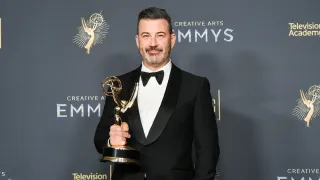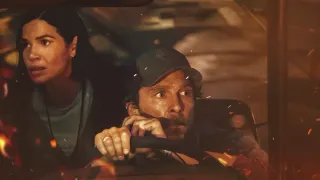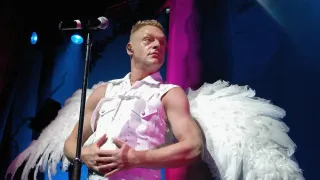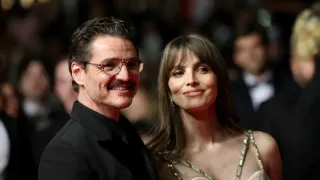October 18, 2022
Choreographer Vincent Paterson Talks Making Iconic Moves for Madonna, Michael Jackson, and Many Others
Jim Provenzano READ TIME: 20 MIN.
While you may not recognize his name, you definitely know his work. That's because Vincent Paterson has choreographed some of the most iconic dances for pop music in the 20th century, including for Michael Jackson, Madonna, Bjork and even Van Halen. His continued accomplishments in film, theater, opera and more are shared in behind-the-scenes stories of his life in his new book, "Icons and Instincts: Choreographing and Directing Entertainment's Biggest Stars."
In his book, Paterson, 72, discusses his difficult upbringing near South Philadelphia, his expansive career, from dancing as a gang leader in Jackson's "Beat It" (and the Weird Al parody, "Eat It!") to staging Cirque du Soleil extravaganzas, choreographing more than 150 commercials, and getting a Tony nomination for "Kiss of the Spider Woman."
Along with being the subject of a documentary film, "The Man Behind the Throne," he's also been a longtime advocate for dancers and choreographers in show business. His journey is a fascinating read, not just for dance fans, but for anyone interested in popular culture and the making of art. In a phone interview from his Hollywood Hills home, where he lives with his husband Rene Lamontagne, Paterson shared some of his stories.
Jim Provenzano: You started dance late and kind of fell into it. Can you explain how that happened?
Vincent Paterson: I had been an actor and a director and had a degree from Dickinson College back in Pennsylvania. But I had never really danced. I was a theater person all the time, and not in great physical shape. I moved to Tucson from the Philadelphia area and I would pass this little ballet studio all the time. Although I never had a desire to learn ballet necessarily, I thought, "Let me see what they do in there." So I opened the door and this woman was teaching young teenage girls ballet, and I thought it looked interesting.
Her name was Stephanie Steigers and she said, "We don't have adult classes, but if you want, you could step into this." I was almost 24 and thought, "Well, nothing to lose." So I went in, and it was so much fun. I approached everything as an actor. I got out books on dance and every time I went to the barre, I would think of myself as another character from a famous ballet. And it helped me as an actor to put on that character somehow. My body responded to it rather quickly. I basically had to break things apart to get it all going again. But it was an incredible revelation, especially because I hadn't been much of an athlete. To have those endorphins zooming through your body is such an incredible natural high.
Yeah, my first years as a dancer were a great challenge, but often thrilling. Let's move to your early work being a dancer for celebrities like Shirley MacLaine, Lynda Carter, Barbara Mandrell, and others. I saw a very colorful Italian TV show excerpt on YouTube.
That was for RAI TV in Italy. Marine Jahan, the girl who was the dance double for Jennifer Beals in "Flashdance," was a good friend of mine. She had been part of a small group of dancers who worked with Michael Peters. He lived here in LA and he taught a dance class and really wanted to get into choreography. So I had just finished with Shirley MacLaine and I had some money for the first time.
And I said, "Well, why don't I just pay for studio space and let's pick some people and you can use this all as your sculpture." So that's what we did for months. And Michael Peters got his voice as a choreographer and we all became much better dancers because of it.
But Marine was one of the girls that I brought into the situation, and after "Flashdance" came out, they asked her to bring a choreographer and a dance partner. She asked me if I wanted to do both. We went to Milan and I put together a dance a week for about seven shows. It was very successful, and it was my first real attempt at choreography.
And the costumes were fabulous! It was always fun to watch the backup dancers on TV variety shows as a kid. My preteen gaydar was on fire. Let's jump ahead to the late Michael Peters and working with him.
Michael had gone to New York to choreograph "Dreamgirls" on Broadway. He asked me to go along, and I actually auditioned for "Dreamgirls" for Michael Bennett, and I got the part of the guy who sings "Got Me a Cadillac Car."
But things were beginning to take off for me choreographically. I just felt like my place was in LA, so I didn't take it and I came back here. But when Michael came back, I was his principal dancer and assistant choreographer. When "Beat It" came up, he said I had to audition. So I did. But having been an actor, I didn't go into the room dressed like all the dancers. The guys at that time wore rainbow colors, jazz stretch pants, tank tops, and leg warmers.
Oh, gosh. Leg warmers. What the hell did they do for us?
I have no idea. It's your ankle. It's not gonna get warmer. So, I came in dressed like what I thought was a street guy. I had my jeans on, I had a striped T-shirt on and a little jacket, and I had greased my hair a little bit and had a hanging earring and a little growth of beard on my face. And I saw Michael Jackson right away up there talking to Michael Peters, saying, "Who's that guy over there?" And of course I danced it fantastically well because it was Michael Peter's work, and I knew it like the back of my hand. So I got the gig, and that began my relationship with Michael Jackson.
It became a kind of event viewing when these new music videos came out. You also were a lead zombie in Jackson's "Thriller."
Which Michael Peters did, and again, I assisted him on. It was remarkable on many levels. Just to be there at that heyday of MTV and be part of this explosion of dance culture was absolutely remarkable. Being an assistant choreographer involves cleaning the dancers' moves, making the piece perfect technically and rhythmically, but also to spend a more intimate time with Michael Jackson. My responsibility was to really be sure he knew what he was doing, that he was comfortable with the movement. So I began to cement my relationship with Mike.
Along with his "Bad" tour and Super Bowl halftime show, you choreographed short films for Jackson's "Black or White," "The Way You Make Me Feel," and other songs. The amazing multi-layered "Smooth Criminal," which Jackson helped by adding more dancers and a bigger set, became a huge production.
It was absolutely incredible. He was still recording his album. He said, "You know, I trust you. Cast it. Get the best people." On a soundstage at Culver Studios where they had begun to build the set, Michael Jackson had them build a raised wooden floor so dancers wouldn't get injured. And so we lived in this place for close to six weeks. He really believed in this project and wanted it to be the best thing that could happen. And it was a great experience. I taught class in the morning, in the same room, and then would move to the set to rehearse.
In your book, you tell how you helped the dancers develop individual characters.
My kind of mission in life has been to take dancers and teach them how to act. I think that so many dancers are called upon to do multiple things and they don't have that expertise, they don't have that knowledge, that training of putting on other characters.
Also, having been an actor and a director, I brought that to the table in the work that I created. And it was fun for them, too. I had them each create biographies of who they were; they had to name themselves. And my goal, of course, was not just to make them into actors or help them find out how to create a character, but for the camera to be able to see that there was something going on in their heads.
Let's switch to Madonna, who was a dancer in college, but when she became popular with her first albums, she didn't completely know how to move herself. You choreographed the "Metropolis"-inspired "Express Yourself" with...?
...with director David Fincher.
...who went on to great acclaim with all kinds of films. Tell the story about how you thought up Madonna's "crotch grab."
(Laughter) The first project I did with her was a Pepsi commercial. Joe Pytka directed. We got off on the wrong foot. When she was introduced to me on the set and Joe said, "I want you to meet Vincent Paterson. He's Michael Jackson's choreographer," she was walking by with her entourage and didn't even look at me, and said, "I don't need a fucking choreographer," and walked away.
And of course I was broken. But anyway, it turned out great. Joseph said, "Please stay, please stay." And I wound up solving some camera movement problems instantly. That gave her a little bit more confidence in me. And then she wound up wanting to jump in and learn what I was teaching the dancers. So that turned out to be a great experience.
And this led to "Express Yourself?"
She called me to do that. But again, I had a little run-in with her because I had created a lot of things that choreographers don't get credit for, like teaching her how to gracefully sit in a chair and hold a cigarette holder, or crawl across the floor like a cat and pour that bowl of milk down her face. I created the movement where she is in her bedroom. We had rehearsed it; it looked great.
But when the cameras rolled, she started doing her own stuff. It wasn't that good, to be honest (laughs). I said, "Madonna, I gave you movement that I think is very beautiful and sexy on your body, but you're doing something else. If you don't need me, I'll just leave." And she said, "No, no. Stay, stay. I'll do it." And so she did it, and she was quite happy.
We got to the shot where she's in a suit at the top of a long staircase. I gave her all this choreography to learn, but at the end there was a little musical button where she needed a moment. And she yelled down to me, "What do I do with my hands for this last beat?" I'm standing there with all the crew and I said, "Why don't you grab your crotch? You've got bigger balls than anybody in the room!"
Classic. She then hired you to replace choreographer Carole Armitage for the "Blonde Ambition" tour to choreograph and also direct it?
She got this bug and decided she was gonna go a different way, with modern dance, which turned out to be a disaster for all concerned. Fortunately for me and for her, she asked me to step in. And after difficult negotiations where she wound up calling my agent and saying, "You know, what the fuck, I'm not a bank," my agent said, "No, Madonna, you're an institution."
Too much!
It was down to the first day they had to rehearse and she still hadn't committed to signing the contract. So I went to a movie because I was so depressed. I thought, "Shoot, I really wanted this gig, but I'm not gonna do it for free."
We didn't have cell phones then. I came home and my answering machine was just bleeping off the table; messages from her manager, from her, and from my agent, all saying, "Get down here. You need to be at rehearsal!" I went down and walked into the room, and the first day I put together the entire stage version of "Express Yourself."
They were about to shoot "Vogue" the next day with David Fincher again. I didn't choreograph the movement of "Vogue." I just put all the movement together to make it a dance. But I don't take choreographic credit for that because Lewis Camacho and Jose Gutierrez did the movement. I just collated it, so to speak, to make it a dance.
So that was the first day. And after that, it was absolute insanity. We had 21 days to do 18 pieces.
What's amazing is you then restructured her entire concert set list to make it a multi-act story. Had anyone in pop music done that?
Well, before that, my friend Toni Basil choreographed David Bowie's "Glass Spider" tour. With Madonna, she was so open because she was in a panic. And me being a theater director, I just said, "Let's group this into sections and give it a theme; Blonde Ambition. You said it, so let's do it." And it worked out really well. And I think that the highlight of it all was the religious section in the center.
Yes. I love the little Martha Graham homage moments in that.
The strong section. It was so much fun to do it, too, but just insanity, crazy things, including the number with the guys being mermaids.
Your take on the Herb Ritts video for "Cherish" is a sweet adaptation.
Thank you. I had so much fun. We all did. And we all worked our asses off because under the time crunch that we had, we had no choice. We had a deadline and it had to get done. So we all worked like maniacs, but we did it. And it was this amazing familial energy amongst all of us; the guys, the two singers, Donna (DeLory) and Niki (Haris), Madonna, me, my assistants Kevin Stea and Smith Wordes. It was incredible, the energy that happened for three weeks was phenomenal.
This is where I think it proves that dancers are the hardest working artists.
Oh, yeah. And in a situation like that, they never complained. When they're being utilized and appreciated, and when there's hard work and yet laughter in the room, I find that it's the ideal situation.
You had a less ideal situation choreographing the film adaptation of "Evita" with director Alan Parker. But you did a great job in blending pedestrian dance movements and tango.
It was difficult with Alan, whose ego was tremendous. I had met with him to do it. I said, "I'm here to fulfill your director's vision as a choreographer." And he kept telling me, "I don't want a lot of dance, and I don't want a lot of rehearsals, because I want it to look organic." And I said, "But Alan, you did 'Fame!' " He fought me the whole time.
Before we began principal photography, I found out why he was so upset. It was jealousy. Alan Parker films had always been Alan Parker films. "Evita" became a Madonna film. And he wasn't accustomed to that. He was used to being the star of his own films.
And because Madonna and I had worked for years over that period of time, we had a relationship. We didn't have a great friendship. I don't do that with celebrities, but we had a great working relationship and a working friendship. He witnessed it, and I think he got very jealous.
And I basically told him, 'Alan, listen, you're the one who hired me. I'm here for you. I'm here to make Madonna look good, so your movie looks good. But if you don't believe me and if you don't trust me, then I don't need to be here and I don't want to be here." So he took a couple minutes and did a 180, and apologized and said, "I'm so sorry. You're right. I have been looking at this the wrong way." And things got slightly better. But it never reached the same kind of relationship that I had with most of the directors I worked with, like Steven Spielberg ("Hook") or Mike Nichols ("The Birdcage").
For the MTV Awards in 1990, you brilliantly refashioned Madonna's "Vogue" into a Marie Antoinette court. That came from working with fans in a studio, right?
I almost had a big project with Diana Ross. I had these fans because I wanted to harken back to the disco era, and I wanted to do a thing with fans. But that project with Diana fell through. So I still had some fans in the closet and I thought, "Let me just take these out and see." I didn't know what I was going to do. I started playing with the fans and thought, "Wow, feels like sort of the Marie Antoinette Court." And Madonna was always trying to come out with a new image every week that people would remember.
I called her and said, "Listen, I got a great idea. You as Marie Antoinette." Madonna jokingly said, "That sounds like shit!" And I said, "Thank you, honey. Why don't I do a little work and you come down and see if you like it, and then we'll go forward. And if you don't like it, maybe you should find somebody else because I've already done 'Vogue' for you three different times." (laughs) Anyway, she was great. She loved it, and the rest is history.
In your book, you frequently mention the Debbie Reynolds Dance Studio, which is where you and Michael Jackson choreographed and created so much, but it was demolished a few years ago.
In 2018; that was such a shame. Debbie had opened up the studio in 1979, and it was a place where everybody worked. It was a huge space over in the Valley, and it had so many rooms and there were dance classes and rehearsals there. It was really a beehive of dance activity. I don't know who it was, maybe Debbie Reynold's son, I can't remember, but he decided to sell the studio and build condos. So I came over at the last minute as they were demolishing the studio.
When they ripped up all the floorboards, I asked them if I could take a bunch of them and they said yes. So I brought them home. Some friends came over, we cut them and sanded them down. We had them engraved to read 'Debbie Reynolds Dance Studio, 1979-2018.' And I sold them to people who were interested.
And I gave all the money to two different people. Donielle Artese, who was a dancer whom I'd worked with many times and in those studios, was very sick and needed a kidney transplant and wasn't able to work. I gave her something like $14,000 to pay her bills. And then the other $14,000 I gave to a charity, Dream A World, that teaches young children in the poorer parts of Los Angeles drama, music and dance after school.
That's so great.
It was a little miracle.
One of your more innovative works was choreographing dances in Lars Von Trier's "Dancer in the Dark," where you got Bjork, Catherine Deneuve, and a full cast dancing in a sink factory and on running train cars. And you played the role of a community theater director.
Lars needed an actor to play the man who runs the little theater, and he hadn't found one. He watched me in rehearsals and said, "Why don't you do it? You're exactly what I need." So I wound up acting in it. He had decided to do the principal photography himself with one handheld camera, and he wanted the dance sequences filmed with 100 mini-DV cameras that had just come out. A very simplified explanation is that they would all be connected to one recording machine.
So the dancers, and Bjork, Catherine, and Joel Grey, only had to go through the piece a few times. But those poor editors had to look at all of that footage to come up with what they wound up with!
It was not well received at first, but now it just stands out as so pioneering, with techniques have since been used in many other works of art, music, and films.
Absolutely. Lars had said he wanted it to have the look of an old Russian film. So it was slightly washed over just a bit, and the colors were a little pale. And the jarring editing was intentional. Lars wanted emotional continuity, not physical continuity.
The train car dance is terrific.
That was hairy. And we used 150 cameras. We shot it in two days, and it was actually the first piece that we shot, and the most difficult.
In one chapter, you seriously discuss dancers' and choreographers' rights, and the problems of not getting credit often for your work, but also the lack of unions or healthcare in the film industry as well.
Broadway has the Society of Directors and Choreographers, which was originated by Bob Fosse. They're all well covered. But here on the West Coast, we are not covered under anything. We are not covered under film work, commercial work, video work, under a tour, fashion shows, anime; nothing.
We're not part of a union. It's been difficult and choreographers have been fighting – me being one of them since the mid-1980s – to make this happen. Choreographers get no credit unless they have achieved a lot of success. If you have a very powerful agent who will fight their ass off, you get credit on a film. There's no union that says you have to have it. That's the first thing for me.
The second is, we have no pension, health, and welfare like every other person that works on the set. We are "work for hire," which means they pay us without extracting taxes. We have to do it all ourselves.
This also means that we don't own anything. We can copyright our work, but it doesn't mean anything, because if we don't own it. Anybody can take it and exploit it, including Michael Jackson's estate. They own all of my work created for him. Michael Jackson impersonators all around the world pay his estate to perform. We get no credit. Michael Peters nor I get any credit for any of that stuff. And this just needs to stop.
We work as hard as everybody else. It comes down to a bit of education that needs to happen. A lot of directors and producers are not even really aware of what a choreographer can do until they get on a set and they see what can happen.
And I think the other part of it is greed. Nobody wants to give up their piece of the pie. So we have a long haul in front of us, but we have created the Choreographer's Guild. And we now have a board, a president, and 40 people that include some of the most prominent choreographers on the West Coast, like Kenny Ortega, Mandy Moore, myself, and Derek Hough from "Dancing With the Stars."
All of us are joining together to extend our information and reach out to other choreographers and get them on board so that our membership will build. I'm about to have a meeting with Bill Kramer, who's the CEO of the Academy of Motion Picture Arts and Sciences – of which I'm a member – and I think there are only three other choreographers in the whole membership. We're discussing how to get choreographers into the Academy. So that's the next thing on my agenda.
Along with readings and interviews for your book, you mentioned your upcoming project, which you can't divulge too much about.
I'm going to direct a huge musical with a lot of movement in it. It's a sexy piece that is set in Shanghai in the 1930s, I can say that much. And it's a lot about girl power. I'm very excited about this piece. We've been working on this for six years. Of course, without the pandemic, it would've only been four, but still feels like we've been on it forever. But it looks like there's a light at the end of the tunnel. My producer is starting conversations with a big producer in Holland who is absolutely joyous over what we presented. So, fingers crossed.
"Icons and Instincts: Choreographing and Directing Entertainment's Biggest Stars," by Vincent Paterson, is available now in hardcover for $25 from Rare Birds Books
www.vincentpaterson.com
www.facebook.com/VincentPaterson
Help keep the Bay Area Reporter going in these tough times. To support local, independent, LGBTQ journalism, consider becoming a BAR member.






